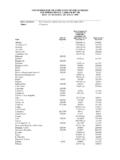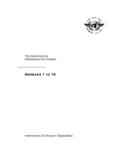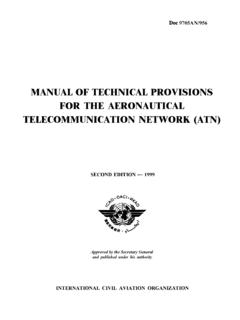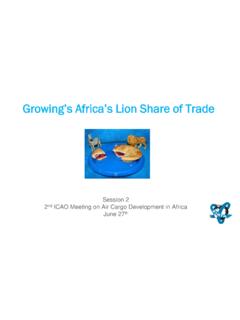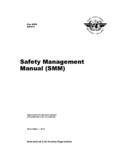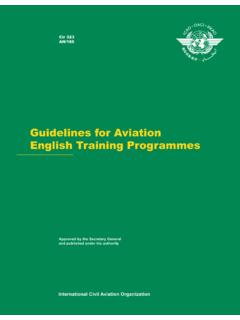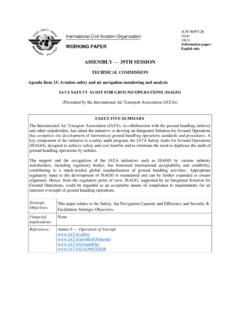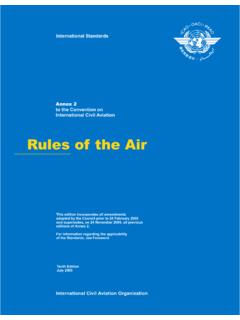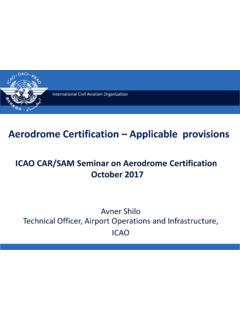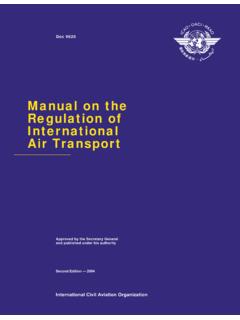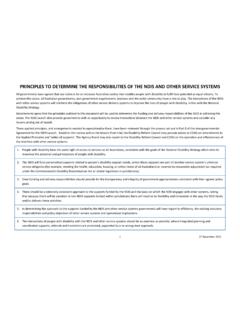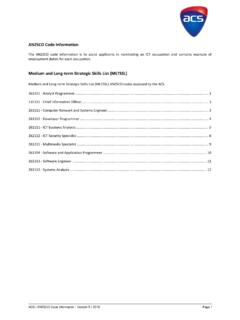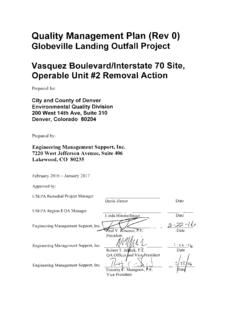Transcription of Quality Management Principles & ISO 9001 Standard
1 Quality Management & ISO 9001 Standard AIM SINGLE ECAR QMS 14TH MARCH, 2016 (ANTIGUA) Definition of Key Terms Te r m Meaning Quality Conformance to requirements Quality Control (QC) A part of Quality Management focused on fulfilling Quality requirements A corrective tool focused on the Quality of output. Example: Validation/software testing, inspection, peer reviews. Quality Assurance (QA) A part of Quality Management focused on providing confidence that Quality requirements will be fulfilled A managerial tool focused on the process of Quality Example: Verification activities, process checklists, project audits and methodology and standards development. Te r m Meaning Quality Management Management activities and functions involved in determination of Quality policy and its implementation through means such as Quality planning, Quality assurance and Quality control) Quality Management System A system comprised of Quality planning and Quality improvement activities, the establishment of a set of Quality policies and objectives that will act as guidelines within an organization, and QA and QC.
2 Process Any activity or set of activities that uses resources to transform inputs into outputs Definition of Key Terms Te r m Meaning Procedure An outline of how to perform a process Purchasing Work Instruction Description of how to perform a task which is a more detailed portion of the procedure Completing a PO Definition of Key Terms Quality Management vs Quality Assurance vs Quality Control Quality Management Quality Management Principles The following Quality Management Principles apply to the broader sphere of Business Management which underlies the ISO 9000 series of Quality Assurance Standards: Customer focus Leadership Involvement of people Process approach Systems approach to Management Continual Improvement Factual Approach to decision-making Mutually beneficial supplier relationships See the following document for explanation of the Principles . The ISO 9001 Standard is based on these Principles ISO 9001:2008 AWARENESS PRESENTATION ISO 9001:2008 is a Business Management System.
3 ISO 9001:2008 AWARENESS PRESENTATION BUSINESS Management SYSTEMS Management Systems means what an organization does to manage its processes or activities in order to: Ensure its products or services meet the organization s objectives Satisfy customers requirements Comply with regulations Enhance customer satisfaction Achieve continual improvement of its performance BUSINESS Management SYSTEMS Formal Management systems instill process ownership which drives excellence. Companies in the field of aerospace, automotive and defense have been operating Management systems all based on the ISO 9001 Standard for years. The ISO 9001 Management system Standard makes these successful practices available for all organizations large and small. BUSINESS Management SYSTEMS As your Management system matures, effective use of the PDCA cycle will ensure continual improvement. WHAT IS THE ISO 9000 SERIES? A set of generic, internationally recognized standards for Quality Management .
4 ISO 9001:2008 is the only Standard in the series that specifies the requirements of a Quality Management system. ISO 9001 FAMILY OF STANDARDS a)ISO 9001:2008 Quality Management Systems Requirements b)ISO 9000:2005 Fundamentals and vocabulary c)ISO 19011:2011 Guidelines for auditing Management systems d)ISO 9004:2009 Managing for the sustained success of an organization A Quality Management approach Only ISO 9001:2008 is auditable. The rest serve as references only. WHAT IS ISO 9001? It is a Quality Management model that can be adopted by any kind of organization The system is focused towards the meeting of customer requirements and enhancing of customer satisfaction Keywords: system requirements satisfaction WHAT IS ISO 9001:2008 QMS - REQUIREMENTS? Quality : degree to which customer requirements have been met Management : coordinated activities to direct and control an organization System : set of interrelated or interacting elements Quality Management system : a system to direct and control an organization with regard to Quality Requirements : a set of Management parameters for your QMS THE ISO 9001:2008 Standard The ISO 9001 Standard is modelled for Quality Management with 5 major clauses: THE PROCESS MODEL THE SYSTEM APPROACH Quality must be managed by a system to be effective This system is done for you, as represented by the ISO 9001:2008 Standard A system is a set of interrelated or interacting elements The System Approach is described in Clause 4.
5 1 The description of Clause 4. 1 matches the PDCA approach to process Management - Plan, Do, Check, Act PLAN What to do? How to do it DO What was planned CHECK Did things happen according to plan? ACT How to improve next time? THE PDCA CONTINUAL IMPROVEMENT CYCLE The ISO 9001:2008 Standard is based on the PDCA (Deming ) Cycle often referred to as the cycle of continual improvement . THE SYSTEM AND PROCESS APPROACH Quality must be managed by a system. The system must be managed using the process approach because the system is made up of processes. These processes are linked to each other. A process has inputs , resources, activities, outputs and customers. Manage them all . ISO LINGO Product = Any output- physical product or services Output = product Product = result of a process Process = a set of inter-relating activities focused towards producing the output Input = requirements Input Process Output PROCESS APPROACH Can be applied to any other process that you manage Input Your process Output PROCESS APPROACH Every process require specific inputs, resources, activities, outputs and customers What you can do now is: Define and document the inputs Define and document the kinds of resources that your processes use Define and document the activities and their interactions Define and document the responsibilities Define and document the outputs Yo u can name this document as Department Control Plan Then execute this plan, and monitor, measure, analyze and improve its performance using Key Performance Indicators (KPIs) Thus, Plan Do - Check Act (Dr.)
6 W. Edwards Deming) ANATOMY OF A PROCESS Process Inputs Activities Outputs Resources Every process has an owner PROCESS Management ISO 9001:2008 ELEMENTS Input Your QMS Output ISO 9001:2008 STRUCTURE Clause 1 Scope Clause 2 Normative references Clause 3 Terms and definitions Clause 4 Quality Management system Clause 5 Management responsibility Clause 6 Resource Management Clause 7 Product realization Clause 8 Measurement, analysis and improvement CLAUSE 1 SCOPE Yo u r organization should consider to adopt the ISO 9001 Standard if it: needs to demonstrate its ability to consistently provide product that meets customer and applicable statutory and regulatory requirements, and aims to enhance customer satisfaction through the effective application of the system, including processes for continual improvement of the system and the assurance of conformity to customer and applicable statutory and regulatory requirements. QMS PROCESSES ARE IN THE CIRCLE CLAUSES 2 & 3 Clause 2 Normative references This document is indispensable in the application of the ISO 9001 Standard : ISO 9000 Fundamentals and vocabulary Clause 3 Terms and definitions Wherever the term product occurs, it can also mean service.
7 QMS GENERAL REQUIREMENTS the QMS processes their sequence and interactions the methods of operations and control resources to ensure effective operations (Clause 6) , measure and analyze processes (Clause to ) the effectiveness of the processes (Clause ) CLAUSE DOCUMENTATION REQUIREMENTS a) Quality Policy b) Quality Manual to describe the system c) Quality Objectives Register to document your Quality objectives d)Control of Documents Procedure e)Control of Records Procedure f)Internal Audit Procedure g)Control of Nonconforming Product h)Corrective Action Procedure i) preventive Action Procedure j) Quality Plan k)Control plans l)Other documents, as necessary m)Records (to show evidence of work performed in all QMS processes) CLAUSE DOCUMENTATION REQUIREMENTS Strategic QMS Procedures (QMSPs) DML, SLAs, MOUs, forms, records, plans, Databases, etc. Tactical Level 4 Level 2 Operations Manual & Work Instructions (OM & WI) Training Manual (TM) Quality Manual (QM) Hierarchy of Documents Level 1 Level 3 CLAUSE CONTROL OF RECORDS Records established to provide evidence of conformity to requirements and of the effective operation of the Quality Management system shall be controlled.
8 Process owners must identify, classify and maintain all process records in good and secure conditions throughout retention period. Records shall remain legible, readily identifiable and retrievable. CLAUSE 5 Management RESPONSIBILITY Top Management m u s t : a)Be committed to the QMS b)Be customer focused c)Establish a Quality policy d)Plan for the QMS in terms of establishing Quality objectives and Management of change e)Assign responsibility, authority and provide suitable communication channels f)Review the QMS performance WHAT TO DO Read the ISO 9001:2008 Standard Establish a Quality Policy Appoint a Management Representative (from mgt. rank) Establish a QMS Committee Establish your Quality Manual Establish the 6 mandatory procedures (Clause ) Establish your Quality Plan Establish your Department/Process Control Plans Establish and document your Quality objectives Establish your KPI s and start collecting data Implement all the procedures KEY PERFORMANCE INDICATORS Balanced scorecard Financials Processes Customers Human capital Ask this question when determining KPI s: As the CEO/Manager of this organization, what data will instantly give me the ability to assess overall performance at any given point in time?
9 Then list all them down and select your desired KPI s. The Balanced Scorecard above provides a comprehensive set of business performance measures Can be used to benchmark performance based on input requirements (customer wants 100 units per month, so give them 100 units per month) Can be used to improve KPI performance levels decision must be based on past performance data and existing capacity to be realistic Yo u can use existing performance levels to establish your Quality objectives Use Quality objectives to improve on productivity levels, decrease errors, improve speed, reduce costs, reduce complaints, etc. Quality Objectives EMPLOYEE RESPONSIBILITY Know the Quality Policy Be aware of the relevance and importance of their activities and how they contribute to the achievement of the Quality objectives Comply with the requirements of the QMS, as stated in the Quality Manual, procedures, Quality Plan, etc.
10 Provide feedbacks or ideas about the QMS Report any nonconformities CLAUSE 6 RESOURCE Management Clause Provision of resources The organization shall determine and provide the resources needed a)to implement and maintain the Quality Management system and continually improve its effectiveness, and b)to enhance customer satisfaction by meeting customer requirements. TYPES OF RESOURCES Determine , provide and manage the following: a)Clause 6. 2 Competent human resources (competency assessment, training needs analysis) b)Clause 6. 3 Suitable and well-maintained infrastructures ( maintenance of buildings, hardware, software, transportation, utilities) c)Clause 6. 4 Suitable and well-maintained work environment (5S program) d)Consider including financial Management in your QMS to ensure product conformity Clause Personnel performing work affecting conformity to product requirements shall be competent on the basis of appropriate education, training, skills and experience.
